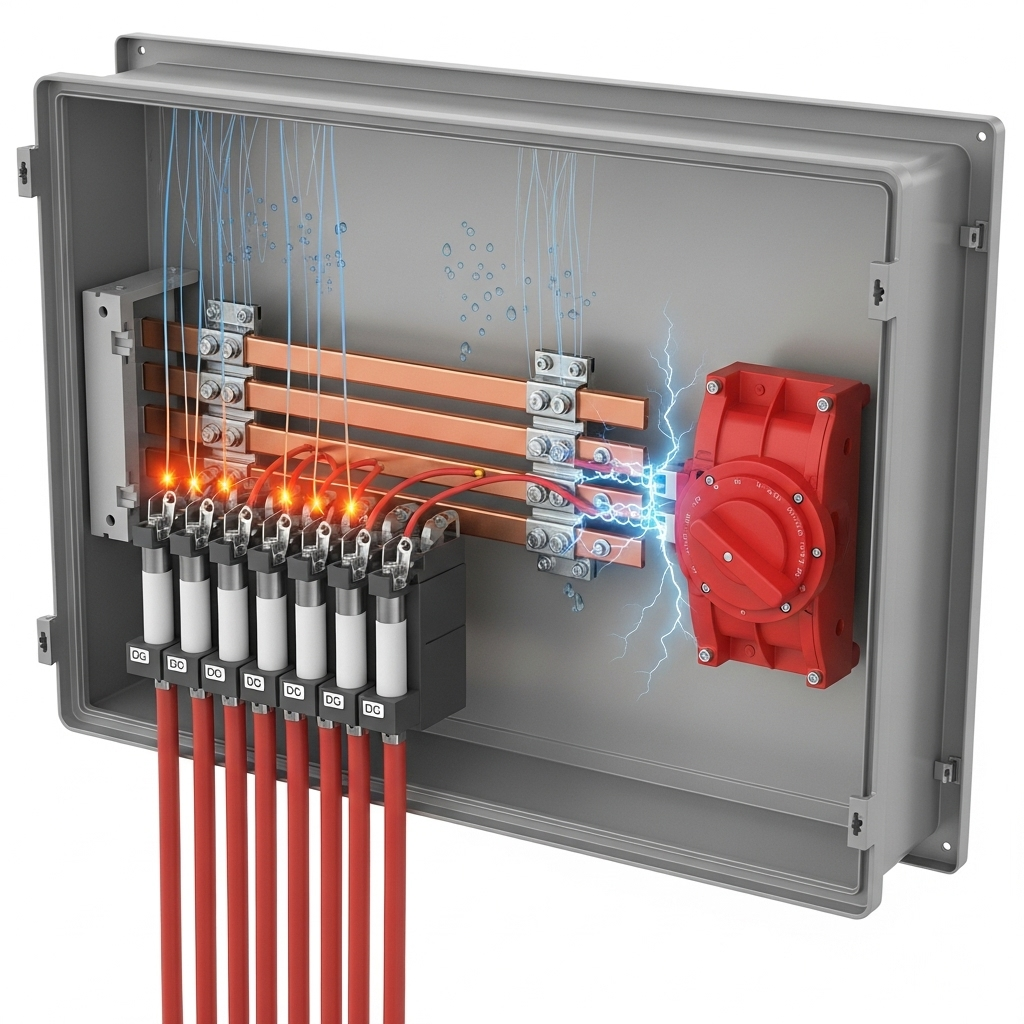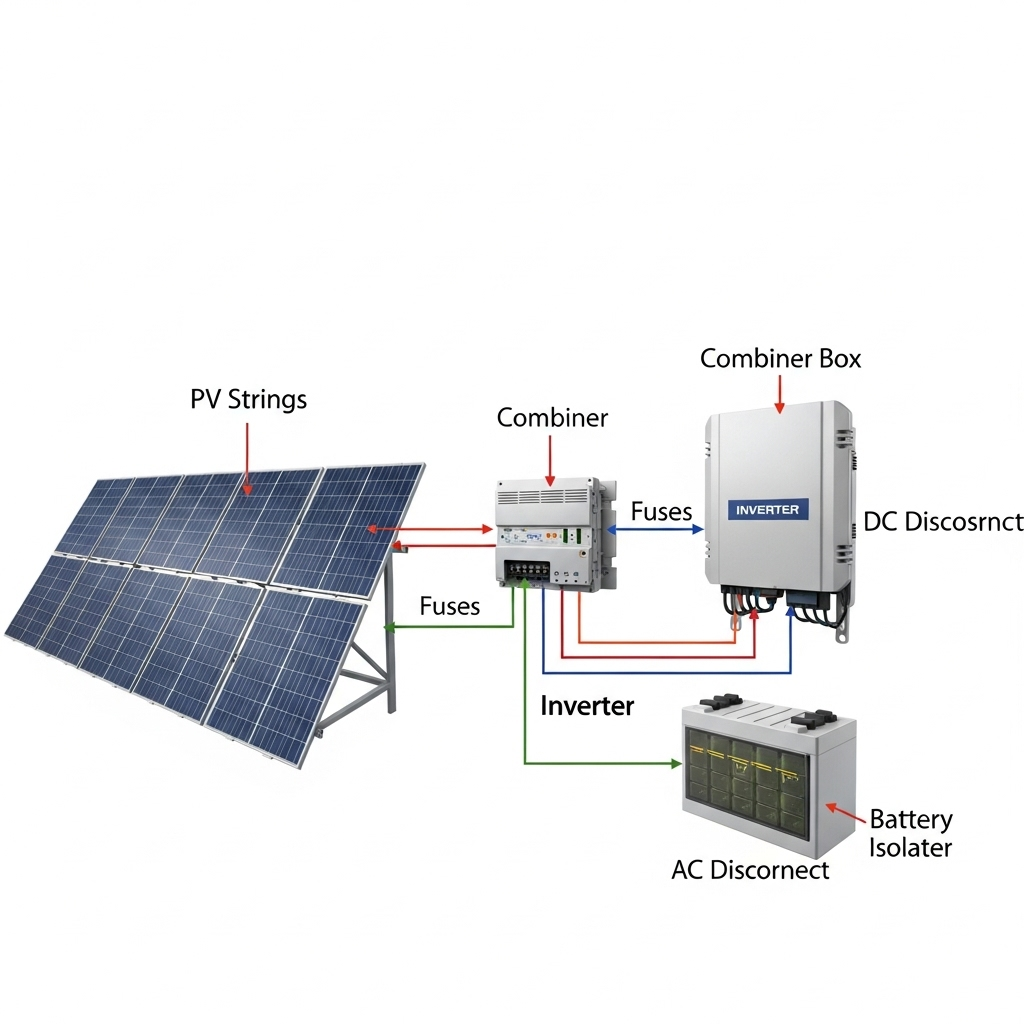PV arrays run at high DC voltage and carry steady current. That stresses disconnects, isolators, and combiner boxes in ways AC devices never see. This piece maps out the dominant failure mechanisms, why they happen, and how to shrink risk without overspending.
Why DC disconnects fail more often than you expect
DC arcs do not self-extinguish at a zero-crossing. Contacts must stretch and cool the arc, or break it in stages. In real sites, small resistances and heat add up.
System context amplifies stress
Modern plants use 1000 V or 1500 V strings. Output currents from a combiner disconnect can sit at 80–250 A for hours. Add summer heat and enclosure warming. A few milliohms at the contact stack becomes real heat.
Example: at 120 A and 2 mΩ, I²R heat is 28.8 W. At 5 mΩ, it jumps to 72 W. That can cook plastic parts and loosen springs. Repeated cycling raises resistance further. The loop accelerates.
Inverter-based grids change fault behavior
With more converter-based resources, available fault current drops. That changes protection behavior and can extend arcing during faults. The point is highlighted in Integrating Solar and Wind: converters limit current to device ratings, so protection schemes need adjustment and fault currents fall near PV plants. Lower fault current can lengthen arc duration inside disconnects during abnormal events, increasing damage.
Growing distributed PV also pushes distribution planning to update screening methods for reverse power flow and reconfiguration, as noted in China Power System Transformation. That planning shift affects which disconnects operate under load and how often they see stressful events.
Top failure modes and what drives them
| Failure mode | Physics in brief | Field indicator | Mitigation |
|---|---|---|---|
| Contact welding or pitting | Arc energy during load-break at high DC; insufficient arc chute or series breaks | Stiff handle, high operating torque, burned odor, rising mV drop | Use DC-PV2 per IEC 60947-3 or equivalent; size for no-load switching; add pre-charge where possible |
| Terminal overheating | Loose torque, strand creep, small contact area, I²R heat in lugs | IR hot spot; discoloration; melted insulation; fuse nuisance trips nearby | Torque audits; use proper ferrules; avoid Al/Cu mix without bi-metal lugs; periodic mV drop checks |
| Ingress and tracking | Moisture plus dust forms conductive paths; UV embrittles seals | Condensation marks; white residue; surface carbon tracks | Pick IP66 or better for harsh sites; correct cable glands; desiccant; maintain gaskets |
| Mechanism wear/misalignment | Frequent operations; sun-heated plastics creep | Intermittent contact; chatter on close; handle not latching | Limit switching under load; record operation counts; choose metal drive trains for high cycle sites |
| Backfeed or polarity errors | Human error; unexpected energy sources during service | Instant fuse blow; loud arc on make/break | Clear LOTO steps; visible open gap; labeling; use interlocks on multi-source cabinets |
Data cues from PV, storage, and O&M
Storage behavior shifts DC stress
Battery C-rate, temperature, and charge policy swing the current profile through isolators in hybrids and ESS cabinets. According to the Ultimate Reference: Solar & Storage Performance, LiFePO4 delivers stable output at moderate C-rates and shows tighter charge limits in cold conditions. Colder packs raise internal resistance, which increases I²R heat at the same current. That extra heat also lands on series disconnects. Plan for current peaks during charge acceptance and inverter transients, and verify disconnect thermal derating at the low end of the enclosure’s temperature range.
DER growth raises event exposure
The energy transition adds more PV capacity each year. More arrays mean more switching events and more O&M tickets across fleets. Market statistics from EIA show rising solar deployment in many regions, which scales exposure hours for isolators and disconnects. More exposure often reveals weakness in installation workmanship and component selection.
Microgrid and islanded operation
Controllers can form microgrids during outages, changing how faults and switching occur. As noted on Energy.gov Solar Energy, PV can support microgrids for resilience. Islanded segments may rely on local disconnects to sectionalize loads. That raises the value of visible isolation, clear labeling, and devices truly rated for load-break at DC.
Combiner box component reliability
Reliability is a system property. A robust isolator helps, but layout matters: airflow, spacing, and the current path through fuses and busbars.
- Thermal design: place disconnects away from hot surge arresters and fuses. Avoid trapping heat at the lid.
- Conductor sizing: keep busbar and cable temperature rise within device specs. Lower resistance cuts heating at the switch.
- Voltage creepage: 1500 V requires longer creepage and clearance. Dust and salt reduce margins; clean and seal.
- Surge and faults: SPD end-of-life can push thermal stress into adjacent plastic parts. Partition heat sources.
| Parameter | Typical range | Reliability impact |
|---|---|---|
| Contact resistance (healthy) | 1–3 mΩ for large DC switches | Every extra mΩ at 150 A adds ≈22.5 W of heat |
| Ambient inside enclosure | +10–25°C over outdoor air | Pushes devices into derating; accelerates aging |
| Operation count per year | 2–20 cycles | Higher cycles increase wear; avoid load-break unless required |
Use these figures as planning cues. Check vendor datasheets for exact derating and resistance values.
Standards and ratings that actually cut failures
- DC category: Look for IEC 60947-3 DC-PV2 rating for 1000/1500 V arrays. It signals tested DC arc control with series breaks.
- North American listing: Use DC-rated switches per UL 98B or UL 508i for PV, not generic AC devices.
- Visible isolation: A visible open gap eases verification and improves safety during LOTO.
- Enclosure rating: IP66 or NEMA 4X helps in salt, dust, or washdown sites. Replace gaskets during mid-life service.
As IRENA notes across integration reports, protection must align with inverter behavior. Combine proper ratings with procedures that avoid live switching under high irradiance or high battery acceptance current.
Field diagnostics that catch trouble early
Millivolt drop testing
Measure mV across the switch at steady current. Track trends. Any sudden jump suggests contact wear or loose terminations.
IR thermography
Scan under >50% load. A hotspot >20–30°C over adjacent parts deserves inspection. Confirm torque and look for discoloration.
Operation counts and no-load switching
Log each operation. Perform routine switching at dawn, dusk, or after inverters ramp down. Avoid opening under max irradiance unless required by procedure.
Moisture control
Add desiccant packs in humid regions. Inspect cable glands. Replace any yellowed or cracked gaskets.
Practical sizing that avoids hidden stress
- Thermal headroom: Size the disconnect for at least 1.25× expected continuous current and verify enclosure derating at local temperatures.
- Arc energy: Prefer double-break or multi-pole-in-series designs for 1500 V strings and arrays.
- Wiring practice: Use crimp tooling matched to lugs. Avoid mixing aluminum and copper without approved bi-metal lugs.
- System events: Consider inverter fault current limits from datasheets. As highlighted in Integrating Solar and Wind, expect lower fault currents than synchronous grids provided, which affects fuse and switch coordination.
Case cues from storage-centric sites
In residential ESS and small commercial hybrids, isolators sit close to batteries and hybrid inverters. High peak currents during charge transitions and low-temperature limits can raise stress on switches. The Ultimate Reference: Solar & Storage Performance outlines how LiFePO4 performance shifts with temperature and C-rate. Plan disconnect ratings and placement with those current profiles in mind. Keep cable runs short, busbar cross-sections generous, and ventilation steady near the switch body.
Putting it to work
- Specify DC-PV2 or UL-listed DC disconnects sized with thermal headroom.
- Place switches for airflow and access. Keep them away from SPDs and fuses that run hot.
- Adopt a simple test set: torque wrench, IR camera, and a calibrated DMM for mV drop checks.
- Schedule switching at low irradiance and track operation counts.
- For microgrids or islanded segments, confirm visible isolation and interlocks. See context at Energy.gov Solar Energy.
As utility screening improves for DER siting and reverse flow, noted in China Power System Transformation, you can align plant-level protection with real inverter behavior and reduce nuisance operations that stress switches.
Our team focuses on reliable energy storage using LiFePO4 and hybrid PV systems. That experience shows simple habits—proper torque, clean enclosures, and correct switch category—solve most PV disconnect switch malfunctions.
Compliance note: codes and product standards vary. Always confirm with the AHJ and current standards. Non-legal advice.
FAQ
What triggers contact welding in PV disconnects?
Opening under high DC current creates a sustained arc. If the device lacks DC-PV2 style arc control or is undersized thermally, contacts pit and can weld. Schedule switching at low current and choose devices rated for DC load-break.
How can I spot a failing isolator early?
Track millivolt drop at a known current, scan with IR, and listen for noisy closing. Rising resistance plus heat is the usual early sign.
Can an AC disconnect serve as a PV DC isolator?
No. AC ratings do not translate to high-voltage DC. Use a DC-rated device with the proper category and voltage. Check local codes and listings. Non-legal advice.
How often should I operate a combiner disconnect?
Keep routine cycles low. Operate during maintenance windows at low irradiance. Record every operation to manage wear.
Does storage change the stress on disconnects?
Yes. Battery C-rate and temperature shift current peaks. As noted in the Solar & Storage Performance reference, cold conditions and high peaks add heat burden to series switches.





Leave a comment
All comments are moderated before being published.
This site is protected by hCaptcha and the hCaptcha Privacy Policy and Terms of Service apply.